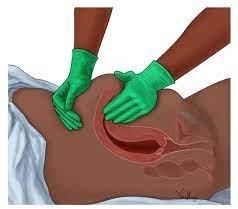A nurse on the postpartum unit is caring for a client who delivered vaginally 3 hr ago.
Which of the following manifestations is a possible indication of postpartum hemorrhage?
Respiratory rate 32/min
Temperature 38.3° C (101°F)
Apical pulse 66/min
Blood pressure 156/80 mm Hg
The Correct Answer is A
A) Correct - An elevated respiratory rate could indicate postpartum hemorrhage as the body compensates for decreased oxygen-carrying capacity due to blood loss.
B) Incorrect- An elevated temperature might indicate infection, but it is not a specific indication of postpartum hemorrhage.
C) Incorrect- A normal apical pulse rate does not specifically indicate or rule out postpartum hemorrhage.
D) Incorrect- An elevated blood pressure might occur for various reasons postpartum, including anxiety or pain, but it is not a specific indication of postpartum hemorrhage.
Nursing Test Bank
Naxlex Comprehensive Predictor Exams
Related Questions
Correct Answer is C
Explanation
A) Incorrect- A reddened area on the calf might indicate a potential blood clot (deep vein thrombosis), which is important to assess but may not be the highest priority.
B) Incorrect- Painful uterine contractions during breastfeeding can be a normal response due to oxytocin release during breastfeeding and might not require immediate reporting.
C) Correct - A urinary output of 125 mL in 4 hours is significantly low and could indicate inadequate fluid intake, potential urinary retention, or other issues that need prompt attention. It is a sign of impaired renal function. This could indicate dehydration, blood loss, infection, or kidney injury. The nurse should assess the client's fluid intake and output, vital signs, urine specific gravity, and serum electrolyte levels. The nurse should also monitor the client for signs of hypovolemia, such as tachycardia, hypotension, and decreased skin turgor.
D) Incorrect- Changing a perineal pad every 2 hours is within the normal range for postpartum bleeding and might not require immediate reporting.
Correct Answer is D
Explanation
Rationale:
A) Incorrect - Applying oxygen is not the priority action in the case of excessive vaginal bleeding and a boggy uterus. Oxygen therapy would be appropriate if there were signs of respiratory distress or decreased oxygen saturation, but it does not directly address the primary concern of uterine atony and bleeding.
B) Incorrect - Administering methylergonovine might be appropriate, but the priority is to address the uterine atony with fundal massage first. Fundal massage helps stimulate uterine contractions and control bleeding, which is crucial in this scenario.
C) Incorrect - Encouraging the client to empty her bladder is important, but it is not the first action to take in the case of excessive bleeding and uterine atony. Immediate intervention to control the bleeding takes precedence.
D) Correct - Initiating fundal massage is the priority action in this situation. A boggy uterus with excessive vaginal bleeding indicates uterine atony, which is a potentially life-threatening condition requiring immediate intervention to prevent further bleeding.
Fundal massage helps the uterus contract and control bleeding. Addressing uterine atony is critical to prevent further hemorrhage and stabilize the client's condition.

Whether you are a student looking to ace your exams or a practicing nurse seeking to enhance your expertise , our nursing education contents will empower you with the confidence and competence to make a difference in the lives of patients and become a respected leader in the healthcare field.
Visit Naxlex, invest in your future and unlock endless possibilities with our unparalleled nursing education contents today
Report Wrong Answer on the Current Question
Do you disagree with the answer? If yes, what is your expected answer? Explain.
Kindly be descriptive with the issue you are facing.
